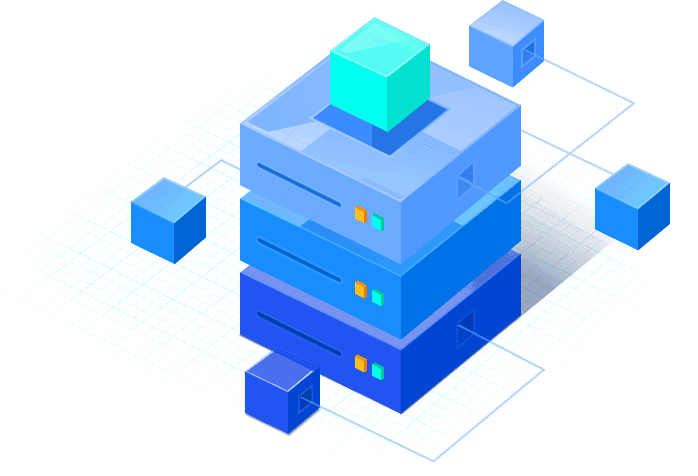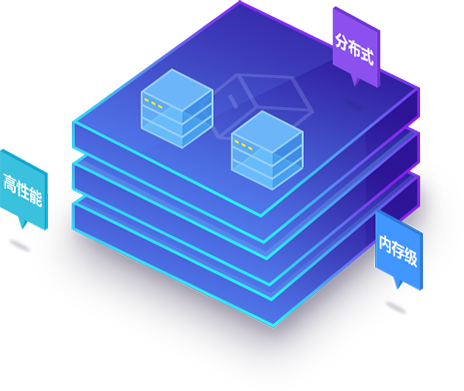At the recently held "Grow with Intelligence (HUAWEI CLOUD & Big Data)" track of the Huawei Global Analyst Summit 2019, Dr. Xiong Ying, chief architect of HUAWEI CLOUD PaaS Products and Services, talked about the development of cloud computing, the development trend of cloud native, and shared his insights regarding the HUAWEI CLOUD intelligent application platform.

Dr.Xiong, chief architect of HUAWEI CLOUD PaaS Products and Services and chief designer of HUAWEI CLOUD intelligent application platform, has more than 20 years' experience in development, architecture, and design of software. As a founding member and director of the Cloud Native Computing Foundation (CNCF), he has attained considerable theoretical and practical experience in the cloud native field.
At the track, Dr.Xiong shared new development trends in cloud native technologies and platforms, focusing on the HUAWEI CLOUD intelligent application platform. He presented three key elements in enabling enterprise digital transformation through cloud native technologies: multi-cloud solutions, ubiquitous containers, and intelligent edges.
Starting with the trend of digital transformation in the cloud era, Xiong suggested that cloud native has become a primary driving force.
According to market surveys and forecasts, in recent years, as enterprises are reducing investment in traditional applications, they are simultaneously increasing investment in cloud-native applications. Today, most enterprises have joined a new round of digital transformation, and are entering the era of cloud-native applications while leaving behind traditional IT applications.
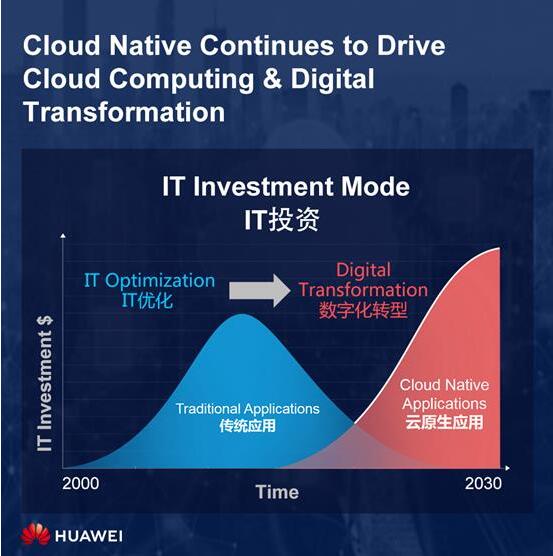
According to data released by CNCF, cloud native technologies have benefited enterprise digital transformation and have also sharply increased activity with open-source communities. The 2018 annual report by CNCF shows that, in 2018, the use of cloud native technologies in production doubled and the number of enterprise users evaluating and preparing to use cloud native technologies more than tripled.
From 2016 to 2018, the number of participants in KubeCon + CloudNativeCon hosted by CNCF also increased by nearly three times.
Dr.Xiong noted that such growth was uncommon in his over 20 years' IT experience. Cloud native technologies are clearly gaining in popularity among enterprises.
Another survey from CNCF showed that enterprises benefit from three top dividends brought by cloud native technologies: faster deployment, higher scalability, and better portability. This survey closely corroborates the feedback Huawei has received from its customers.
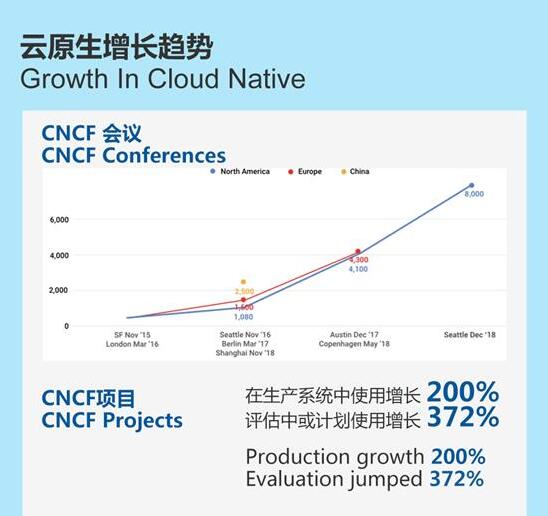
Dr.Xiong believed that cloud native technologies require deep cultivation. HUAWEI CLOUD has included cloud native in its strategic technology investment scope since 2015. Now, HUAWEI CLOUD has made great achievements in the field and has become a leader in cloud native technologies.
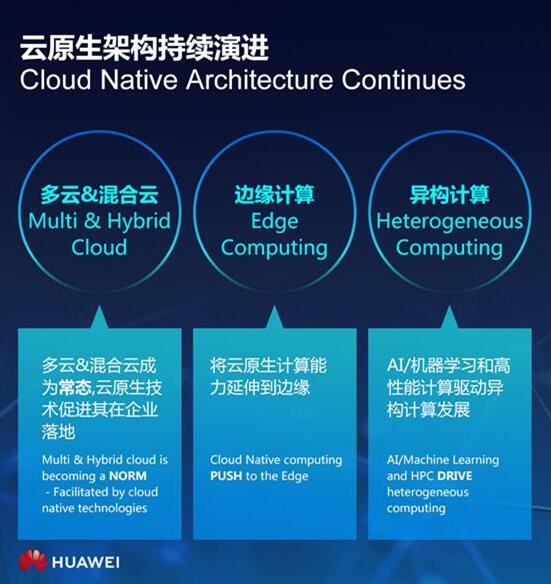
Today, cloud native technologies have been deployed commercially in multiple industries and domains, taking full advantage of their architectural benefits. However, cloud native architecture still needs to be developed and expanded to meet the higher performance and reliability requirements of many applications.
Through continuous participation in technical communities, frequent and meaningful communication with business accounts, and cooperation and exploration with ecosystem partners in the cloud native field, HUAWEI CLOUD presents three development trends in the integration between cloud native technologies and businesses.
1)Multi & hybrid cloud is becoming a NORM for enterprises, and it will be accelerated by cloud native technologies. According to the latest hybrid cloud market survey of the China Academy of Information and Communications Technology (CAICT), more than half of enterprises are actively investing in hybrid cloud. The portability of cloud native fundamentally solves many technical difficulties in implementing multi & hybrid cloud, and helps to accelerate the implementation of a multi & hybrid cloud strategy.
2)Computing capabilities should be pushed to the edge. Next-generation cloud computing is not a centralized supercomputing center, but a ubiquitous cloud formed by pervasive, distributed edge networks that connect thousands of edge nodes. Cloud native technologies will become an indispensable technical aspect of this model.
3)Cloud native technologies must support heterogeneous computing. With the large-scale use of AI and machine learning, cloud native technologies must support heterogeneous computing capabilities, such as GPU, FPGA, and ARM, to provide higher performance computing resources for cloud and edge nodes and enable cloud-native applications to run more efficiently.
It is becoming clear that Huawei is leading the trend of cloud native technologies. This is not only because Huawei invested in cloud native technologies earlier than other national enterprises or even some foreign enterprises, but also because Huawei has continued to innovate in this field. Huawei continuously launches products based on customers' requirements and is ahead technologically of other enterprises.
HUAWEI CLOUD intelligent application platform is evolving out of cloud native technologies to make digital transformation more intelligent.
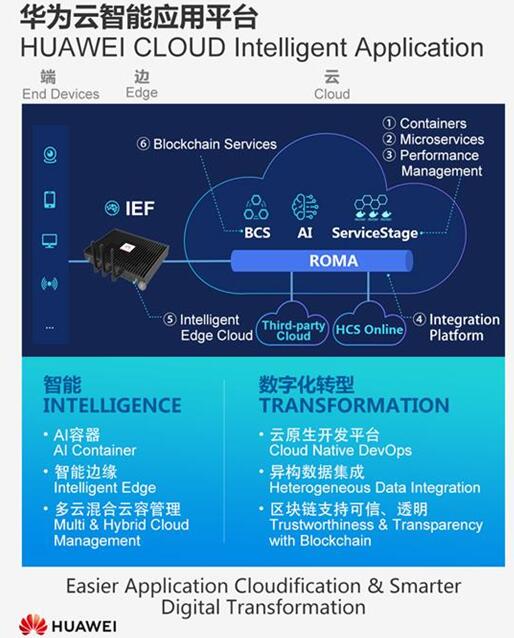
The design of the HUAWEI CLOUD intelligent application platform 3.0 has considered the three trends in exploring the business value of cloud native technologies. Aware that enterprises will have more business needs for intelligence and a higher expectation for digital transformation, HUAWEI CLOUD goes further beyond cloud native technologies. While continuing to help enterprises race ahead into the intelligent world, HUAWEI CLOUD provides the secret ingredients they need to catch up with IT industry trends. One of the secret ingredients is ROMA, a platform that can connect traditional applications. Another is the Block Chain solution.
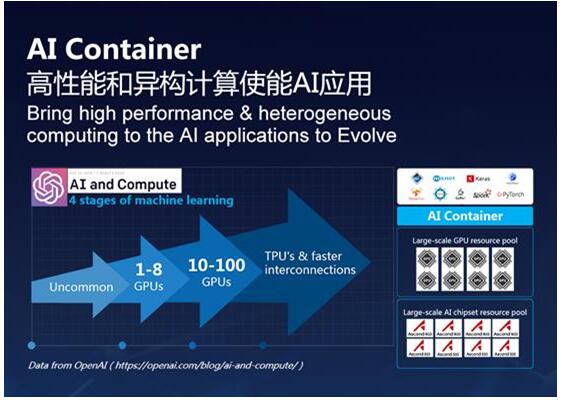
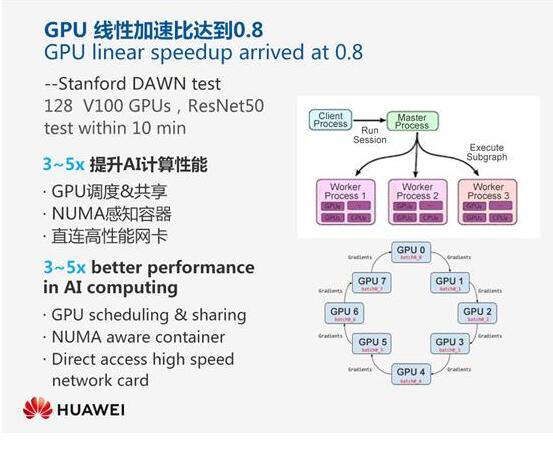
With optimized stacking of software and hardware, AI containers provide the horsepower needed to perform AI training at scale.
Computing performance is essential to AI. According to data from OpenAI, the use of GPUs in the AI field has evolved from single-host multi-GPUs and multi-host multi-GPUs to AI chips. The support for FPGA and heterogeneous computing is particularly important in the next phase. It is predicted that 128-GPU parallel computing will be the norm for machine learning. GPU scheduling across clusters will significantly improve overall computing efficiency.
To make the impossible possible, HUAWEI CLOUD container services have made a few advances. First, our containers support GPUs and AI chips ahead of rivals to bring the heterogeneous computing power of GPUs and Ascend chips to AI training on a large scale. Second, hardware advances have also provided benefits: the hardware-aware NUMA bare-metal architecture and high-speed InfiniBand network cards optimize the stacking of software and hardware, so bandwidth on the resource pool network can reach 100 GB to support massive parameter synchronization during distributed training. Third, K8S scheduling is deeply optimized to fit into AI scenarios. Features like queuing, affinity, and Gang Scheduling can work closely with the AI distributed training framework to beef up computing efficiency during distributed AI training.
Thanks to these advances, HUAWEI CLOUD is far ahead in Stanford DAWN testing. Compared with the traditional GPU speedup mode, the AI computing performance of deep learning improves by 3 to 5 times. When 128 GPUs are used, the linear speedup ratio reaches 0.8, 50% higher than the industry standard.
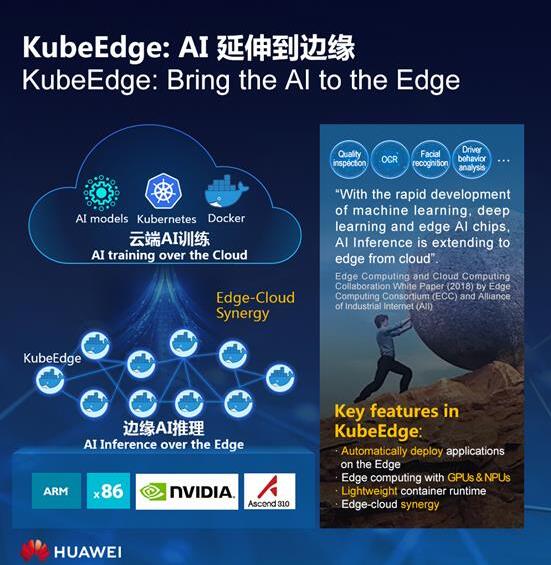
When it comes to the edge computing field, we see KubeEdge is extending AI to the edge to form a ubiquitous intelligent edge network. According to IDC research, 50 billion terminals and devices will be connected to the network by 2020 and generate ever-larger volumes of data. 50% of this data will be analyzed and processed at the edge of the network, and 90% of processing requests come from AI computing. Common edge computing solutions do not consider intelligent applications or compatibility with intelligent chips. When AI inference is being pushed to the edge, the complexity of resources, monitoring, and scheduling at the edge will increase exponentially as the network grows in size, which directly impacts the overall computing efficiency. There is already a pressing need to improve edge management.
KubeEdge was born out of HUAWEI CLOUD with the vision of Cloud Native and is now an open source project under CNCF. It addresses portability of intelligent applications and makes the goal of building a ubiquitous intelligent edge network possible. KubeEdge is the first edge computing project accepted into CNCF and has become an architectural standard for intelligent edge computing.
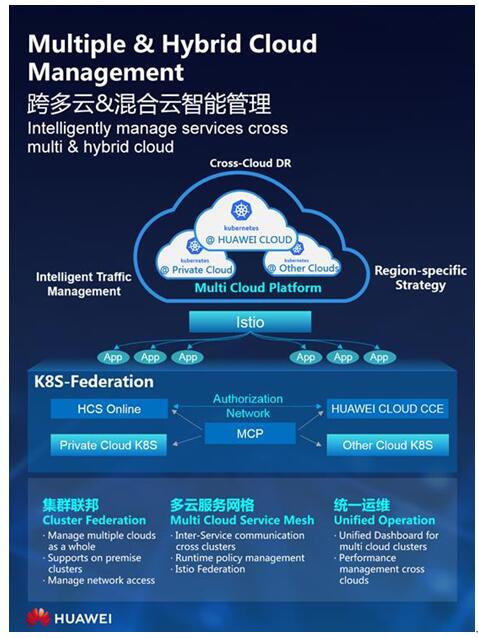
Multi & hybrid cloud is becoming the norm. For enterprises interested in migrating to the cloud, it is a top priority to manage, deploy, and operate cloud native applications across clouds. HUAWEI CLOUD is the first cloud service provider to unveil a multi & hybrid cloud management platform. The following features were made available in March this year:
Automatic disaster recovery across clouds: A single workload is load balanced across multiple cloud providers. Workload instances can be automatically migrated from a faulty cloud to other available clouds in seconds.
Elastic scaling across clouds according to custom traffic policies: When load spikes occur on a cloud, traffic will be diverted to other clouds where auto scaling can be completed in seconds.
Access based on region affinity: If instances of an application are deployed across regions, requests to access this application will be geographically distributed to physically closer clouds to reduce latency.
HUAWEI CLOUD announced the first commercial multi & hybrid cloud container management platform in the cloud native field, which was nearly one month earlier than Google released their rival product, Anthos.
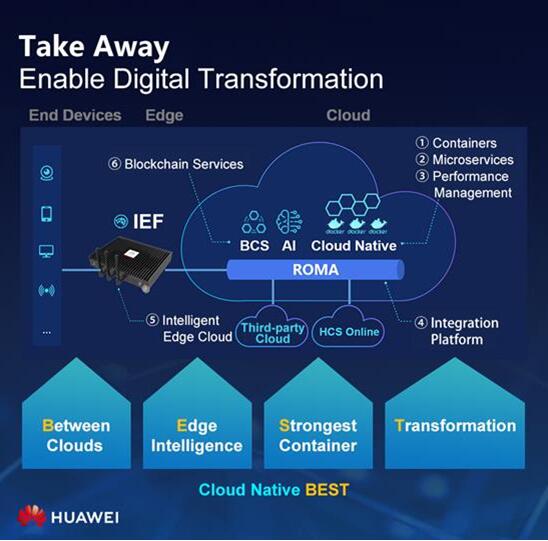
Digital transformation has taken off. The Cloud Native BEST strategy will drive digital transformation across all sectors.
HUAWEI CLOUD intelligent application platform is widely used in sectors like the Internet, education, finance, and biomedicine, and it will fuel digital transformation in all sectors in the cloud native era.
Xiong closed his presentation with the proposal of Cloud Native BEST: We are in the IT transformation journey. Artificial intelligence and cloud native technologies are the best driving forces to fuel enterprises' digital transformation. Huawei has long forecast this trend, built an intelligent application platform, and mobilized around the vision of Between Clouds, Edge Intelligence, Strongest Container and Enable Transformation to bring cloud native and digital transformation to more enterprises.





